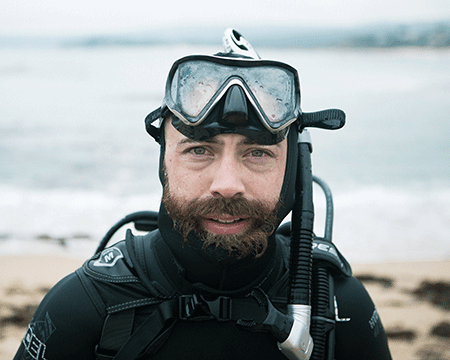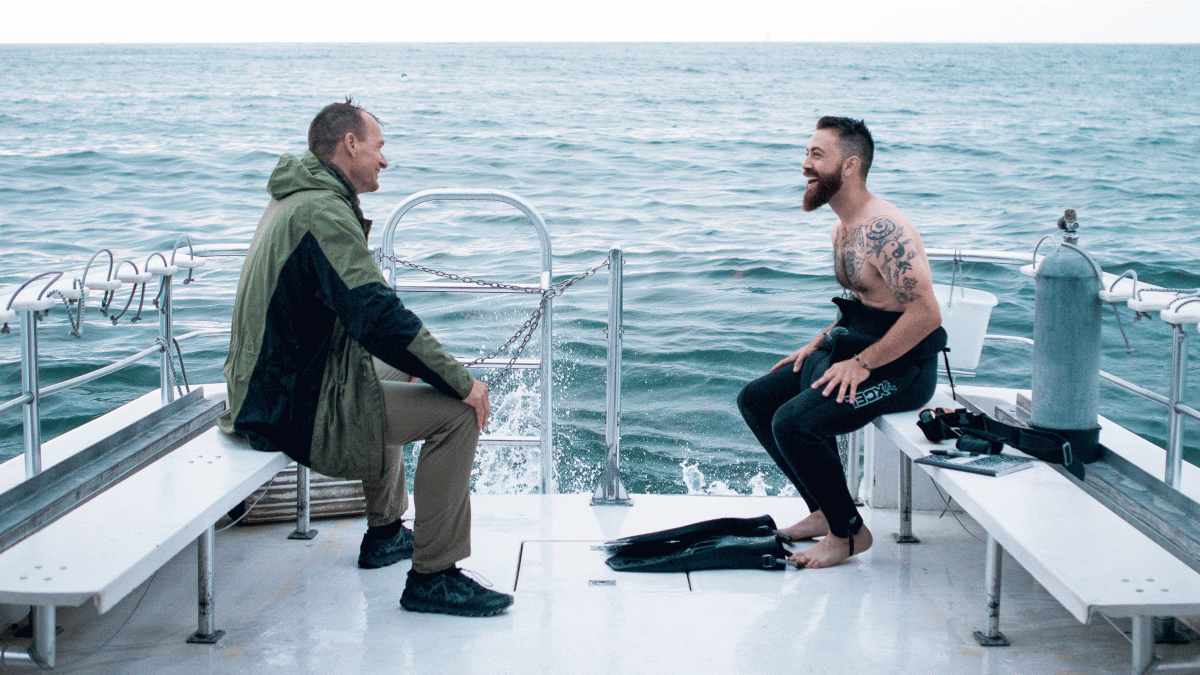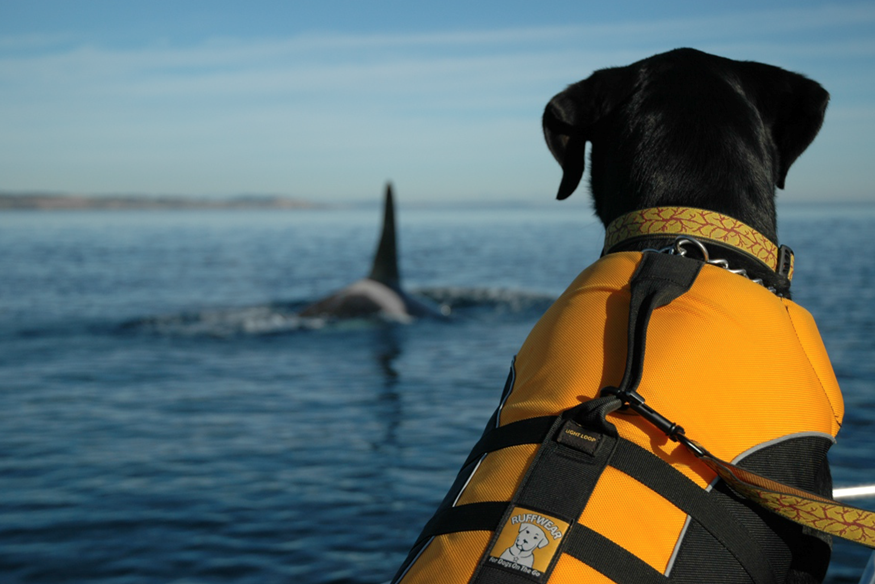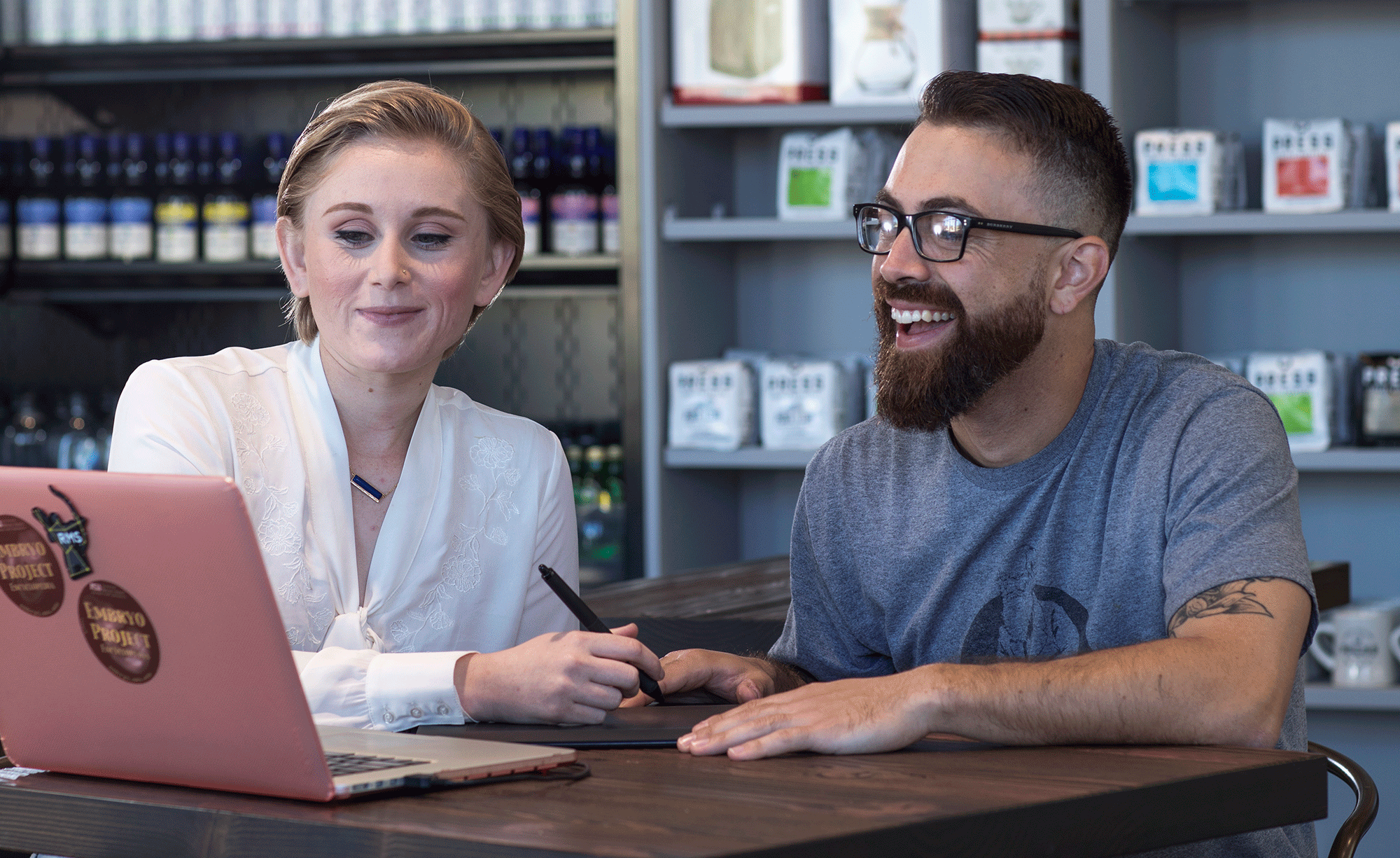Charlie Rolsky seems to be everywhere you look on campus. Tossing carne asada on a fire on a desert camping trip with biology students. Participating in an interpretive dance performance in the Biodesign Institute. Selling biology-inspired T-shirts for charity.
With tattooed sleeves, the beard of a Sumerian general and a passion for the now, he tends to stand out. The impression comes across that he is savoring every moment and making the most of everything life offers.
Rolsky was born in Southern California and raised in Washington and Montana. “We lived in the most beautiful places,” he said. He grew up outside; camping, fishing, hiking. His mother fought the development of wetlands in Montana. His grandmother lived in the redwoods. “My family was really environmentally conscious,” he said.
He’s working on a doctorate in biology with a focus on microplastics, and assessing environmental stressors as an indicator of species, human and ecosystem health.
What the latter means can be summed up in two words: whale poop.
“I have a fascination with the ocean the way some people do with space,” Rolsky said. “When you’re sitting on a boat, you don’t know what’s underneath you. It’s so hard to study things in the ocean. You can’t just take them out and put them in a lab and replicate the same setting.”
Killer whales are his favorite animal
“Marine mammals — they surface and then they go under,” he said. “You have (just a moment) to study and then what are you going to do?”
He did an internship studying killer whales. Usually to take a sample from a whale, you take a biopsy sample. That involves getting close to the whale and taking a chunk out of its hide.
Needless to say, that stresses the whale. Rolsky and his colleagues used a noninvasive way of taking a biopsy: a trained rescue dog that alerts them when it smells killer-whale poop. The dog stood on the bow of the boat, the boat followed the whale, the dog alerted team members when the whale did its business, team members scooped up the sample with a net.
Charlie Rolsky’s research team used a dog trained to smell whale poop, which they’d collect and analyze in the lab. Photo courtesy of University of Washington Center for Conservation Biology
Out on the ocean on that internship, getting his hands dirty, Rolsky found his calling. Collecting samples, taking them into the lab and analyzing the data, he saw the whole flow of how the process worked.
“That one internship just blew the roof off for me,” he said.
He knew he wanted to be a scientist.
There was a problem, though. When he was an undergrad, he struggled with grades and a health condition.
“It hindered me in the sense it was overwhelming and I took it on on my own,” he said. “I needed to ask for help, and I didn’t. It was a battle for me to balance everything. I thought I could balance too many things, and I definitely couldn’t.”
His grades took a hit.
Flash-forward to getting into a research lab as a graduate student. He needed an adviser.
“There’s not a lot of easy options to get into a research lab,” Rolsky said. “My grades weren’t the best when I was an undergrad, so I had to rely on my resume to get me places. I shopped myself around to a lot of different professors, but their ruler for measuring success is usually your GPA. I got shot down left and right.”
He connected with a student of Rolf Halden’s who worked in aquaculture. All three of them went to lunch, where Rolsky showed his ideas to Halden.
Halden is an expert in determining where mass-produced chemicals wind up in the environment, how they affect health and how to remove them from contaminated water and soil. The Food and Drug Administration recently banned the sale of personal-care products containing antimicrobials that contaminate the environment — a direct result of Halden’s research. He is the director of the ASU Biodesign Center for Environmental Health Engineering. A lanky German with a winning smile, he stands out for also being sharply dressed on campus.
“Once I learned who he was, I didn’t think I had a chance in hell of working with him,” Rolsky said. “I sat down and I said, ‘Here’s my resume. I’m really sorry. Back when I was an undergrad –’ And he said, ‘I don’t care about that. What are you doing now?’ That’s when the conversation started. He looked at me as more than a GPA. Who are you? What are your passions? What’s your work ethic? Stuff like that.”
Rolsky walked away from lunch without a good feeling.
“He basically crapped all over (my ideas), in a really good way because I was new,” he recalls. “I left and called my mom and said, ‘Well, that was a massive failure. Now I feel like an idiot.’ Then he sent an email saying something like, ‘We’re excited to have you. Welcome to the team.’”
Rolsky had won Halden over with his enthusiasm. Grades don’t always convey a person’s capacity, HaldenHalden is also a professor in ASU's School of Sustainable Engineering and the Built Environment, in the Ira A. Fulton School of Engineering. said.
“Sometimes bad grades can be a reflection of an educational environment that is not ideally suited for an individual,” Halden said. “Being a very large university, ASU is a place where people with different learning styles have a better chance finding the right niche. A history of having not-so-great grades doesn’t mean he couldn’t do great work. Charlie is proving this more and more.”
Assembling a scientist
Halden said he looks for people who like what they’re doing. Passion makes a difference. He explains why he invited Rolsky into his lab.

Charlie Rolsky is working on a doctorate in biology with a focus on microplastics, and assessing environmental stressors as an indicator of species, human and ecosystem health. Photo by Josh Soskin
“(People) can be extremely smart, but absent of motivation, what should be an exciting journey of discovery becomes a chore only,” he said. “It’s much easier to work with people who are self-motivated and just direct them, to give them pointers on what they might be doing next. It was beneficial to us both. He already had the motivation, and all he needed was a little more instruction on how to apply his skills.
“I wouldn’t say I took a chance on him. Yes, based on his academic accomplishments, not everyone would have taken him on, but Charlie has become such an integral part of our team that we are just happy to have him around and work with him.”
Halden pushed Rolsky toward microplastics. He will finish his doctorate in about a year and a half. He wants to be back on the water, getting his hands dirty at a place like the National Oceanic and Atmospheric Administration or the Woods Hole Oceanographic Institute. Currently he is working on a survey of plastics in California waters.
“We’re encountering negative stuff,” Rolsky said. “Not a surprise.”
It’s an area where very little research has been done, making it a ripe career field.
“We don’t know much about it, and it’s one of those problems where it’s so expansive, that once we do learn bad things, it’s not good,” he said. “It’s not one little problem in one little area. Microplastics are all over the world. Every country can get worried.”
Halden said with some nudging Rolsky has come into his own.
“I think he’s really broadened his horizons and focused in on a major challenge that is the mass production of unsustainable materials that have become part of our way of life and we don’t want to do without,” Halden said.
Rolsky said he didn’t know where he’d be if Halden hadn’t encouraged him in that direction. A good scientist is assembled from different pieces.
“I had done the field work, I’d gotten decent at writing, but he taught me how to be a scientist,” Rolsky said. “He taught me how to ask the right questions and see things through the glasses of a scientist.
“You can think you’re good at things, but it takes someone like that to show you the proper way of executing stuff. He really opened my eyes to how to be the best scientist possible. You can see from your perspective all angles of a certain concept, but then you take it to him and he adds 10 more things to it.”
To Rolsky, Halden represents what’s needed in science.
“A lot of people don’t know how to communicate or to find creative ways of communicating science to non-science people,” he said. “He can communicate well, he brings creativity out of people, and he pushes you to be the best researcher possible.”
Now Rolsky is reaching out. He gets samples sent to him from all over the world by ordinary people interested in science.
“Everyone has a generic idea of what a scientist should be and how they should talk and what they should look like,” he said. “When you can be the opposite of that, it’s a positive thing to me. ‘Oh, he doesn’t talk like a scientist, and he’s funny and has tattoos and looks weird.’ If you can be an exception to that and get people to care about science in a funny way, then I think that’s pretty cool.”
Paying it forward
As a teaching assistant, Rolsky tries to get as many students into research labs as he can because it helped him so much. Over the past three years, he has helped 28 students get into lab positions.
“I had to figure out how to get into research labs on my own,” he said. “Now it’s like an equation I can pass off to anyone and it’s pretty successful. I haven’t had a student fail yet.”
Anna Guerrero was one of his first. A first-year grad student, she is pursuing her master’s in biology and society. Rolsky was her teaching assistant in her Introduction to Biology lab.
“The great thing about Charlie is that he was super-open, super-clear to his students that he wanted to help them find research opportunities from the get-go,” Guerrero said. “Undergraduate research is becoming more and more integral to the success of an undergraduate in the science field. He’s like, ‘Hey, if you want to get into a research lab, please come to me. I will help you brainstorm who you should contact and use my contacts to help you get in.’”
Guerrero is interested in how scientists transform their experiences into data, words and pictures. She is particularly interested in “invisible” scientific phenomena, things too small, large or abstract to see with the naked eye.
“We got her into a really amazing position,” Rolsky said. “She has a knack for art and science, so we paired her with a researcher who depicted anatomical structures in a really cool way.”
ASU students Anna Guerrero and Charlie Rolsky help connect people to science. Photo by Mark Lipczynski
Guerrero said Rolsky was probably the only reason she got into a lab.
“I came to him with this interest in art, but I also like science,” she said. “I didn’t know who would need that or where should I go. He said, ‘Oh, there’s this woman, her name’s Rebecca Fisher. She’s really cool and her papers she publishes usually have these really wonderful illustrations, so she has a history of working with illustrators. I know her; I’ll vouch for you.’ I think that’s why she gave me an interview in the first place.”
Guerrero went to work in Rebecca Fisher’s anatomy and physiology lab.
“I can draw — I’m a scientific illustrator,” Guerrero said. “In anatomy and physiology it’s super helpful to have an illustrator to draw the phenomena you’re seeing. Sometimes when you’re taking pictures of 20 muscles, you don’t want every muscle in the picture; you just want to isolate one. So she took me on. I did some drawings and figure work for her early on. She kind of inducted me into the lab, into dissections, and then I helped her on a few projects.”
As a thank-you, she drew Rolsky a picture of Darwin with the caption “Darwinning.” Rolsky came up with the idea to put it on a T-shirt. Now they design and sell science-based T-shirts for charity. (Find their designs at teespring.com/stores/lab-casual.)
“I try to be like Charlie now that I’m a TA, and offer the same sorts of things to my students. Sometimes it gets overwhelming with the amount of things you have to do, but it’s totally worth it,” she said. “It’s important to be that person, especially with younger students who wouldn’t know how to do it.”
Rolsky is a natural teacher. He has received awards and recognition for his contributions to education at ASU.
“He is a sought-after instructor people go to repeatedly,” Halden said. “This is all very impressive. The students like him and can relate to him, which makes learning so much easier and fun.”
Rolsky said his journey has been about finding a niche and a place to make his mark.
“You find the right people,” he said. “I tell my students about finding your pod — you find the right people who are always going to lift you up and provide you with opportunities. As long as you’re nice to people and make an effort to reach out and talk to them, I think that should be the standard.”
Top photo: ASU researcher Rolf Halden (left) and graduate student Charlie Rolsky. Photo by Josh Soskin. This story appeared in the January 2018 issue of ASU Thrive magazine.
More Science and technology
2 ASU faculty elected as fellows to National Academy of Inventors
Arizona State University faculty members Bertram Jacobs and Klaus Lackner have been elected as fellows to the National Academy of Inventors (NAI). Both are being honored for research that…

Harvesting satellite insights for Maui County farmers
Food sovereignty can refer to having access to culturally significant foods, but Noa Kekuewa Lincoln believes it goes farther than that.“I think the concept goes beyond the foods themselves to having…

Google grant creates AI research paths for underserved students
Top tech companies like Google say they are eager to encourage women and members of historically underrepresented groups to consider careers in computer science research.The dawn of the era of…


